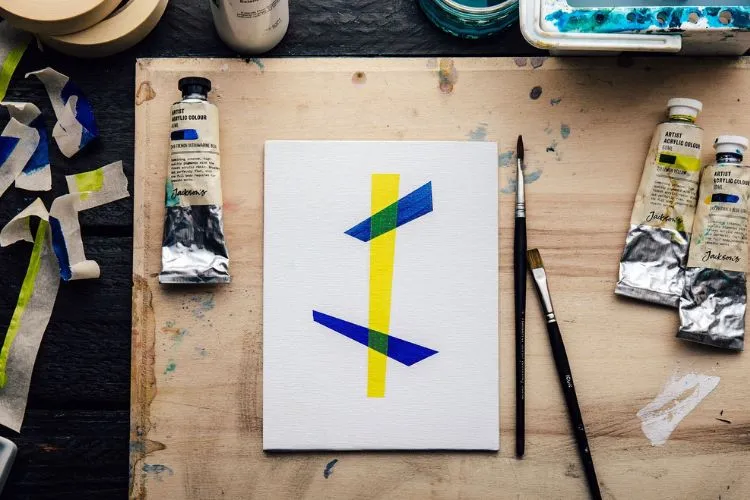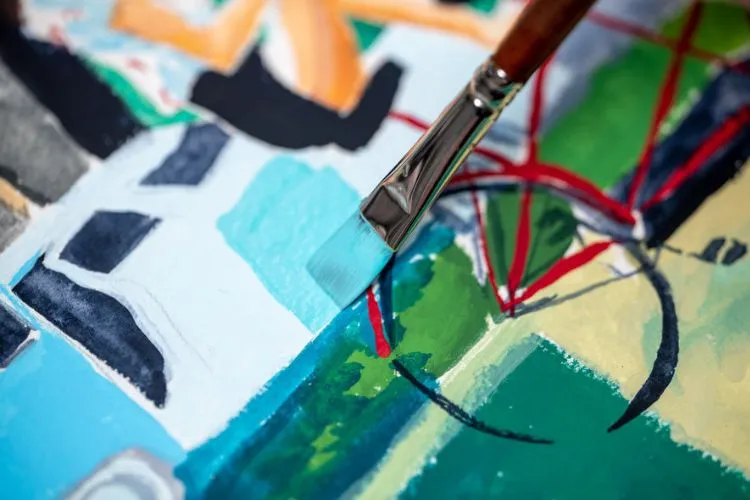When it comes to painting, acrylics are a favorite for their versatility and vibrant colors. However, artists often face a challenge that can dampen their creative spirits: sticky acrylic paint.
This can turn an enjoyable painting session into a frustrating ordeal. This article delves into the reasons behind the stickiness of acrylic paint, how to prevent it, and solutions to fix it if you find yourself in this sticky situation. Let’s find out, is acrylic paint sticky?

Is Acrylic Paint Sticky?
Acrylic paint dries through a process of water evaporation. What remains is a plastic polymer film. This process can be affected by several factors. Humidity, temperature, and the thickness of the paint application play significant roles.
High humidity slows down the drying process, leaving the paint tacky. On the other hand, lower temperatures increase drying times, contributing to the problem.
Common Causes of Stickiness
Apart from environmental factors, other causes contribute to the stickiness. Mixing mediums improperly can result in a painting that never dries correctly.
Applying paint too thickly may also leave the surface tacky. Acrylics are known for their quick-drying properties, but this can be a problem when thick layers are involved.
Preventing Acrylic Paint from Becoming Sticky
Pre-Painting Strategies to Avoid Stickiness
Preparation is key in avoiding a sticky situation. Preparing your painting surface with a primer, such as gesso, ensures a more absorbent ground. This helps prevent the paint from sitting on top of the surface for too long.
Choosing the right environment is also crucial. A well-ventilated area with moderate humidity and temperature can greatly reduce the chances of sticky paint.
Best Practices During Painting
While painting, techniques matter. Thin layers allow the paint to dry quicker and more evenly, reducing stickiness.
Waiting for each layer to dry fully before applying the next one is critical. This patience pays off in achieving a finish that is smooth and free from tackiness.
Solutions for Sticky Acrylic Paint

Immediate Actions if Paint Becomes Sticky
If you notice stickiness while you’re working, don’t panic. Adjusting your environment can help.
Try using a dehumidifier in high humidity or moving your project to a warmer area. These small adjustments can make a big difference in the drying time.
Fixing Already Sticky Paint
For paintings that remain tacky days after application, long-term solutions exist. Applying a sealant or varnish can sometimes solve the problem, locking in the stickiness underneath a protective layer.
However, this should be a last resort after trying to let the paint dry naturally for an extended period in an optimal environment.
Case Studies and Troubleshooting
Real-Life Scenarios
Let’s consider a scenario where an artist painted a thick layer of acrylic on a humid day. The surface remains tacky after several days.
By moving the artwork to a room with controlled temperature and using a fan, the problem begins to diminish. This practical example shows how environment plays a role and how simple changes can offer solutions.
Advanced Troubleshooting
If stickiness persists, it might be time to assess the damage. Sometimes, starting fresh is more feasible than trying to save a sticky painting.
Remember, it’s important to identify what went wrong to avoid repeating the same mistakes. Consulting with other artists or a professional might provide insight into unique solutions based on their experiences.
Layering Techniques to Avoid Stickiness
Mastering the skill of applying paint layers correctly can greatly enhance the quality of your acrylic paintings and prevent the common issue of stickiness.

Here are some essential insights into perfecting thin layers and timing their application:
Mastering Thin Layers
- Use Additives: Incorporating slow-drying mediums or thinners can help in extending the working time of acrylics and facilitate the application of smoother, thinner layers.
- Choose the Right Tools: Opt for softer, finer brushes which allow for gentler and more even distribution of paint. This approach helps in achieving a thinner coat in each layer.
- Consistency is Key: Aim for a consistency similar to that of heavy cream for your acrylic paint. It should be fluid enough to spread easily but not so thin that it becomes transparent or runny.
- Practice Dilution Techniques: Learn to dilute your paint correctly with water or an acrylic medium. Too much water can break down the paint’s binder, so a medium can be a safer choice for maintaining color intensity and adhesion.
Timing Your Layers
- Dry to the Touch: Wait for the first layer to be completely dry to the touch before adding another. This can vary from a few hours to overnight, depending on the thickness of the layer and environmental conditions.
- Use a Hairdryer: For quicker layering, you can gently use a hairdryer on its lowest setting to speed up the drying process between layers. Be cautious not to overheat the paint or surface.
- Observe Changes in Sheen: The sheen of the paint often changes from glossy to matte as it dries, which can be an indicator that it’s ready for another layer.
- Consider Environmental Factors: High humidity and cooler temperatures prolong drying times. Adjust your layering timing accordingly or modify your environment if possible.
Adhering to these techniques not only helps in preventing stickiness but also in building depth and texture in your work, enhancing the overall quality and durability of your acrylic paintings.
Frequently Asked Questions (FAQs)
Why can acrylic paint feel sticky days after painting?
Acrylic paint can remain sticky due to high humidity, low temperatures, or thick application. These factors slow down the drying process.
How can you tell if your painting environment is causing the stickiness?
Assess the humidity and temperature of your workspace. High humidity and low temperatures are likely culprits.
Is there a quick fix to reduce the tackiness of an acrylic painting?
Adjusting your environment can help. Use a dehumidifier for high humidity or move your artwork to a warmer, well-ventilated area.
Understanding the Chemical Composition of Acrylic Paint
To fully comprehend why acrylic paint can become sticky, it’s useful to understand its chemical composition. Acrylic paint consists of pigment suspended in an acrylic polymer emulsion.
This emulsion is essentially a mix of acrylic resin, water, and other additives. The drying process involves the water evaporating, leaving behind a plastic-like film that hardens over time.
Additives in Acrylic Paint: Manufacturers often include additives to improve the paint’s texture, consistency, and drying time. These additives can impact the paint’s performance in different environmental conditions.
Some additives can make the paint more flexible and durable, while others can affect the drying process, contributing to stickiness if not used correctly.
Using Varnishes and Finishes
Applying a varnish or finish can not only protect your acrylic paintings but also address the issue of stickiness. Here’s how different types of finishes can help:
Gloss Varnish: A gloss varnish can enhance the vibrancy of colors and add a protective layer to your painting. It can also help seal any sticky areas, making the surface smooth and less prone to collecting dust and grime.
Matte Varnish: For a non-reflective finish, a matte varnish is ideal. It provides a protective coating without the shine, which can be particularly useful if you prefer a more subdued appearance for your artwork.
Satin Varnish: Satin varnishes offer a compromise between gloss and matte finishes, providing a slight sheen without being too reflective. This type of varnish can help balance the appearance of your painting and reduce stickiness.
Applying Varnish: When applying varnish, ensure that your painting is completely dry to avoid trapping moisture. Use a clean, soft brush or a spray varnish for even application. Allow the varnish to dry thoroughly before handling the painting.
Innovative Solutions and Products
The art industry continuously evolves, offering innovative products designed to tackle common issues like sticky acrylic paint. Here are a few products and techniques that can help:
Anti-Stick Mediums: Some manufacturers offer anti-stick mediums that can be mixed with acrylic paint. These mediums are designed to improve the drying process and reduce tackiness, making them a valuable addition to your painting supplies.
Acrylic Retarders: Retarders are additives that slow down the drying time of acrylic paint, allowing artists more time to work on blending and layering. Using retarders can help achieve smoother layers, reducing the likelihood of stickiness.
Humidity and Temperature Control Products: Investing in a hygrometer to measure humidity levels in your workspace can help you maintain optimal conditions.
Additionally, portable dehumidifiers or heaters can be used to control the environment, ensuring that your paint dries evenly and thoroughly.
Real-World Applications and Artist Tips
Experienced Artists’ Insights: Many experienced artists have faced and overcome the issue of sticky acrylic paint. They often suggest working in thin layers, using high-quality paints, and maintaining a clean workspace.
Some artists recommend using a palette knife for thicker applications, as it can help spread the paint more evenly.
Studio Practices: Maintaining a clean and organized studio can also prevent issues with sticky paint. Dust and contaminants can settle on wet paint, causing uneven drying and stickiness.
Regularly clean your brushes, palettes, and other tools to ensure a pristine working environment.
Experiment and Document: As you work with acrylic paint, take notes on what techniques and products work best in different conditions. Documenting your process can help you identify patterns and avoid issues in future projects.
Conclusion:
Sticky acrylic paint doesn’t have to ruin your art projects. With the right knowledge and precautions, you can prevent and fix this common issue.
Remember the importance of the environment, the way you mix and apply your paint, and the solutions available if you encounter tackiness.
By following these tips, your paintings will dry to perfection, ready for the world to see.

Meet Isabella Anderson, your acrylic painting mentor with over a decade of brush-wielding mastery. Dive into the colorful world of acrylics with her expert guidance, featured exclusively on ‘Acrylic Authority.’ Unleash your inner artist and explore the limitless possibilities of this versatile medium alongside a true acrylic aficionado.
